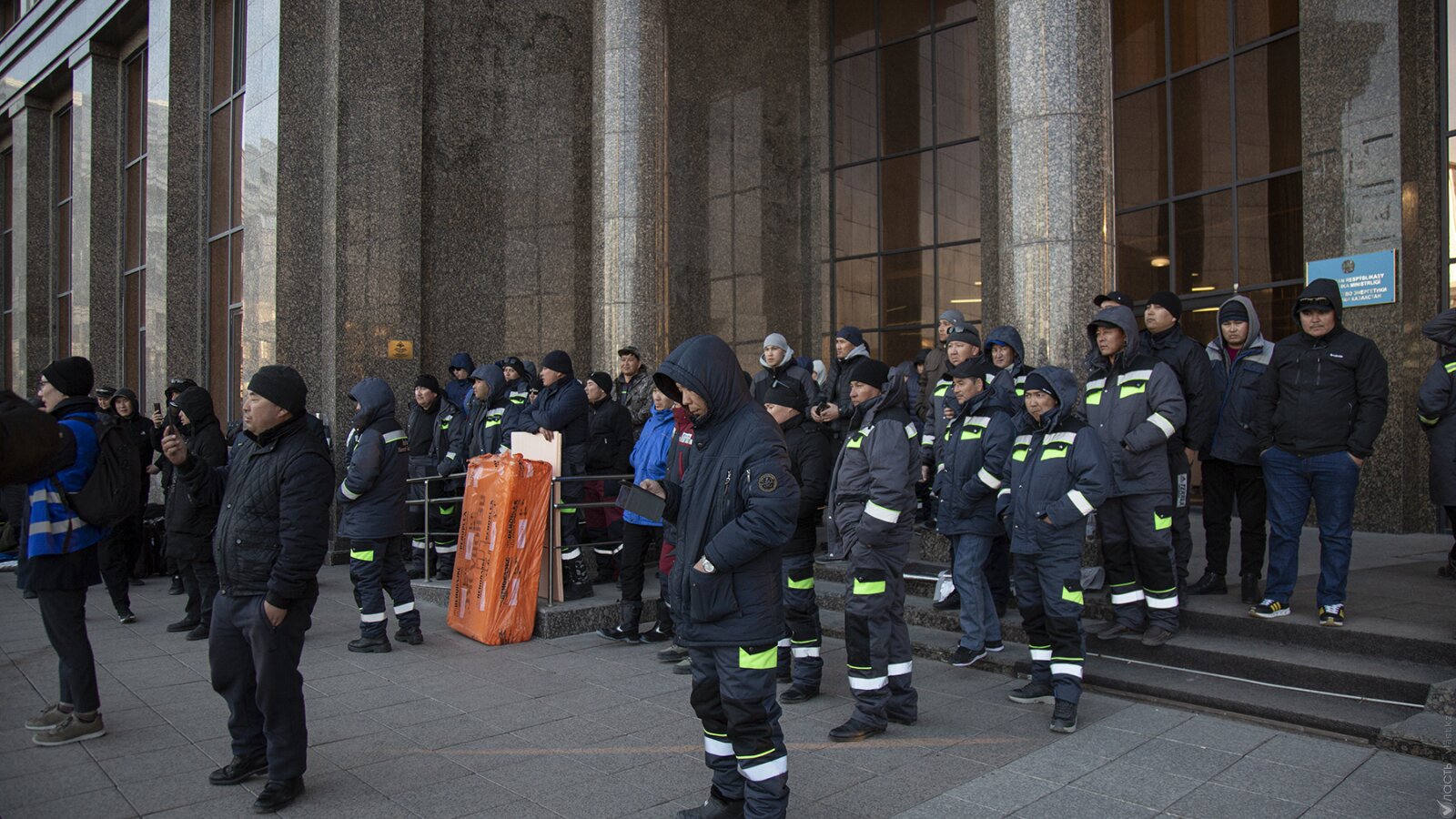- ВКонтакте
- РћРТвЂВВВВВВВВнокласснРСвЂВВВВВВВВРєРСвЂВВВВВВВВ
Oil workers from Zhanaozen carried out a protest last week in Astana. Around 150 laid-off employees of the BerAli Mangistau Company spent a night outside the building of the ministry of energy, demanding to be hired directly by Ozenmunaigas, the principal oil and gas producer in the Mangistau province and subsidiary of the state-owned Kazmunaigas. In the evening of April 11, the oil workers were detained and some even suffered injuries as they were dragged into police vans.
Their detention lasted a few hours. The government later organized their transfer back to Mangistau on a special train, allowing only 10 of their leaders to remain in the capital for the following negotiations.
Kazmunaigas rejected their demands for a permanent job at Ozenmunaigas, which workers argued would have given them greater financial stability and social protection. The oil workers, on the other hand, said they rejected the authorities’ proposal to increase the terms of the contracts from one to five years because this measure would not significantly improve their conditions.
On April 14, the workers said that the negotiations had stalled and this could lead to new protests.
Since independence, the workers at oil and oil service companies have regularly organized mass protests and strikes. The largest was in 2011, when the security forces suppressed an eight-month workers strike at Kazmunaigas’ subsidiary companies. The repression did not stop labor actions, which increased in frequency in the past five years.
Corporate PR and state propaganda argue that the workers are selfish and greedy. The workers are often depicted as privileged, earning exponentially more than the average resident. The reasons for their dissatisfaction, however, are structural. This is what makes the oil workers one of the most protest-prone groups. Until a solution is found, strikes and pickets are poised to repeat.
Outsourcing Contracts
The three largest oil fields in Kazakhstan account for around two-thirds of Kazakhstan’s oil production. Foreign participation in the operation of these fields is significant, with US corporation Chevron, UK’s Shell, and Italy’s Eni having played a major role since the mid-1990s.
They brought their international standards, gave out above average salaries, and set strict safety conditions at their companies. At the same time, however, they spread the practice of splitting up vertically-integrated enterprises typical of the Soviet era and contributed to translating into Kazakhstan the practice of subcontracting.
The principal companies separated themselves from third-party responsibilities by outsourcing services to other companies, which did not always observe the same rules, standards, and safety measures. By assigning work through tenders, the main players pushed subcontractors to compete for a finite number of jobs, which in turn prompted companies to cut costs for both technology and labor. The length of the subcontracted agreements also became shorter and shorter, negatively affecting job stability.
In towns where the main economic activity is oil and gas extraction, such as Zhanaozen or Aksai, losing a tender could be a question of life or death for subcontracting companies. By losing tenders, companies have had to lay off workers and become idle until the main extractive companies announced another tender. The laid-off workers are sometimes rehired by companies that win tenders, often at comparatively lower salaries. Should the worker disagree with the conditions, the company could pick from a large number of workers from other companies that lost the tenders.
Outsourcing Jobs
The number of workers in oil and gas projects can sometimes inflate by thousands of workers, especially at the time of major renovations at oil fields and processing plants. In an effort to maintain temporary contracts flexible, companies have implemented in Kazakhstan the global standards of outsourcing labor. By hiring workers through manpower agencies, which have become widespread since the early 2000s, the principal companies avoid inflating their own staff and can delegate all responsibility for hiring and firing to third-parties.
Through this practice, the workers become pawns at the mercy of the seasonal workflow at the oilfields. During the weeks and months that they are needed, they have work, sometimes even well-paid. But when a phase of work stops, or when a renovation is completed, or when a company loses a tender, then they are out of work. In turn, this makes their “well-paid salaries” not constant throughout the year.
In addition, their work cannot be compared to salaried office workers. Companies often criticize workers for “being greedy” and wanting salaries well above the country’s average (around 300,000 tenge, or around $650 per month). In fact, however, those who work in the oilfields are generally paid by the shift, not monthly. Which means that, unlike office workers or medical workers, they do not have paid time off. Only some of the largest oil companies pay salaries that, spread out across the year, can afford the oil workers a “good life”. But as outsourcing becomes increasingly widespread, these jobs become rarer.
Because of the outsourcing of contracts and the outsourcing of labor, several people wearing different overalls, branded with different company logos, often work at the same job in the same oilfields. Importantly, however, they are subject to different work conditions, safety standards, and salary levels. This creates a condition of inequality across the people working in the oilfields, which they seldom can correct or fight against, because of the lack of independent trade unions.
Suppressing Trade Unions
For three decades, Kazakhstan’s government passed laws restricting workers' rights to strike and to formulate collective demands. The laws often mirrored the neoliberal standards set up with the aid of trans-national companies in several other countries relying on the extractive sector.
The authorities constantly used violence against trade union activists: they were killed, beaten, intimidated, and prosecuted. This led to the disintegration of all independent workers' associations and prevented the creation of new ones.
Furthermore, the activities of trade unions were systematically discredited by state institutions, which claimed they were in charge of protecting workers' rights. Government agencies and state-sponsored trade unions also sought to absorb independent labor organizations.
Workers’ actions are still perceived as a hostile element by the government. Since the workers have no other channels of communication, protests remain the only way to voice their concerns.
Witnessing the End of Oil
Employees of oil enterprises in the Mangistau region are very dependent on the subsidiaries of Kazmunaigas (Ozenmunaigas, Mangistaumunaigas, and Embamunaigas). These companies are the largest employers in the region and the main customers for local oilfield services firms. Smaller, private companies only operate a few smaller oilfields. But their gradual depletion will lead to a decrease in purchases of local services.
By 2030, the so-called “big three” (Tengiz, Kashagan, and Karachaganak) will account for almost three-quarters of all oil production. The share of small and medium-sized oilfield production will continue to decline. Therefore, the market for oilfield services, which is already controlled by large companies (the top-10 companies commission 87% of the contracts), will be increasingly less competitive.
Despite local legislation on “local content” demanding otherwise, the operators of large deposits give preference not to local, but to foreign contractors who have opened their own subsidiaries in Kazakhstan or participate in Kazakhstani legal entities. Therefore, they occupy a dominant position in the structure of the oilfield service market (56% of the total number of enterprises). The largest companies still lack trust in local entrepreneurs, because of corruption and potential administrative interference.
If the authorities do not find a way out, Kazmunaigas will be practically the only customer for services for Kazakhstani oilfield services companies. Some of these companies will eventually disappear, because production volumes at the main Kazmunaigas subsidiaries will also continue to decline and will not allow them to absorb the excess workforce. In the absence of other oil jobs, the number of unemployed oil workers will inevitably grow.
Поддержите журналистику, которой доверяют.








